Thursday, 13 June, Impressionists at Louis Vuitton and tasting at Jacques Faussat
Written 15 June 2019
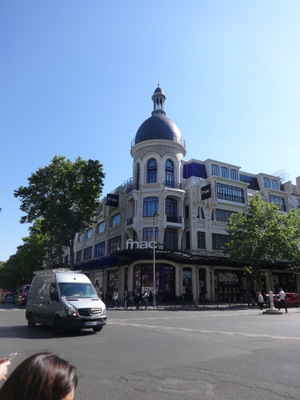
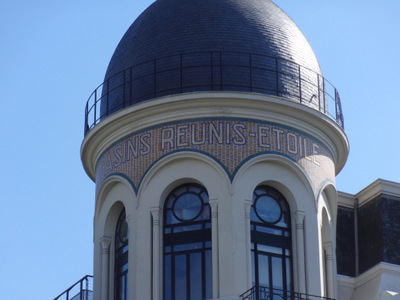 On Thursday we had tickets for 1 p.m. to visit the Fondation Louis Vuitton in the Bois de Boulogne to see a special exhibition that included some impressionists. Accordingly, we set out on foot for Étoile to catch the Vuitton's electric shuttle bus, which starts running at 11 a.m. The plan was to get to the foundation in time to have lunch at their restaurant before visiting the collection. On the way, we passed this lovely old building with decorative corner towers. Colored tiles around the top of each cupola read "Magasins-Reunis Étoile" (United Stores, Étoile), but the building is now occupied by a FNAC (Fédération Nationale d’Achats des Cadres), which sells electronics, books, and recordings.
On Thursday we had tickets for 1 p.m. to visit the Fondation Louis Vuitton in the Bois de Boulogne to see a special exhibition that included some impressionists. Accordingly, we set out on foot for Étoile to catch the Vuitton's electric shuttle bus, which starts running at 11 a.m. The plan was to get to the foundation in time to have lunch at their restaurant before visiting the collection. On the way, we passed this lovely old building with decorative corner towers. Colored tiles around the top of each cupola read "Magasins-Reunis Étoile" (United Stores, Étoile), but the building is now occupied by a FNAC (Fédération Nationale d’Achats des Cadres), which sells electronics, books, and recordings.
Also along the way, in a smaller side street, we passed a storefront (right next to a Kosher butcher shop) labeled "Allo Kippa" ("Hello Kippa"), and yes, it makes custom-embroidered yarmulkas.
Following the little map printed right on our shuttle tickets, we arrived at the appointed location in the Avenue de Friedland a few minutes early to find a queue of about 70 people already waiting for the shuttle! Okay, not a disaster, it runs every 15 minutes. When it arrived, though, the shuttle turned out to be small—limited to 20 passengers. Fortunately, a second one showed up just a couple minutes later and took another 20. When they returned at 11:15 a.m. for their second load, we got onto the second one.
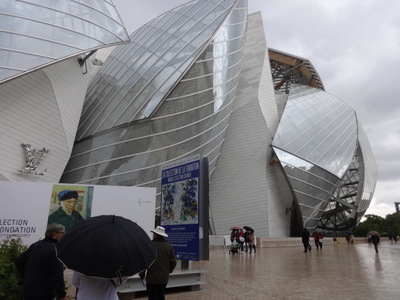
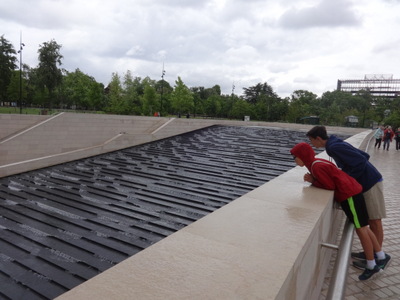 At the foundation, we found three looong queues waiting to get in: one for people buying tickets, one for people with tickets to get in on the hour, and (the longest) one for people with tickets to get in on the half hour.
At the foundation, we found three looong queues waiting to get in: one for people buying tickets, one for people with tickets to get in on the hour, and (the longest) one for people with tickets to get in on the half hour.
The foundation's building was hard to photograph, mostly because I couldn't get far enough away, but as you can see, it's curvilinear and futuristic. We stood there for a while in the "on the hour" line, in the rain, until a staff member happened by with an armload of signs. She explained that the "half-hour" line was currently processing 11:30 tickets and would finish that before starting on the noon tickets in our line. When I explained our plan to have lunch first, she pulled us out of line and sent us around the far side of the building. On the way, we passed this great stair-stepped fountain, engineered so that the water fall down the steps in little waves, rather than in parallel sheets.
Also on the way, we passed through the edge of the Jardin d'Acclimatation (once a royal botanical garden, now a children's amusement park), where I saw Canada geese, geese with striped heads (Anser indicus?), magpies, wood pigeons, and white and ordinary peacocks, some with spread tails). On that side, we were admitted without respect to the time on our ticket and went straight to the restaurant.
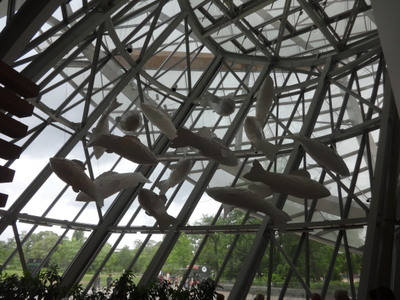
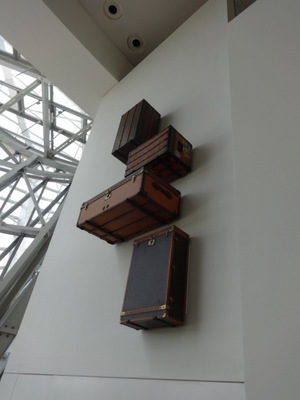 The restaurant is called "Le Frank" for Frank Gehry, who designed the building. He also designed the giant, glowing fish that hang from the restaurant's ceiling and serve as lighting fixtures. It's hard to see in my photo because they're silhouetted, but they're entirely white and constructed of translucent white scales as big as dinner plates.
The restaurant is called "Le Frank" for Frank Gehry, who designed the building. He also designed the giant, glowing fish that hang from the restaurant's ceiling and serve as lighting fixtures. It's hard to see in my photo because they're silhouetted, but they're entirely white and constructed of translucent white scales as big as dinner plates.
And because the namesake of the foundation is, in fact, that Louis Vuitton, this collection of steamer trucks graced the wall above the hostess station.
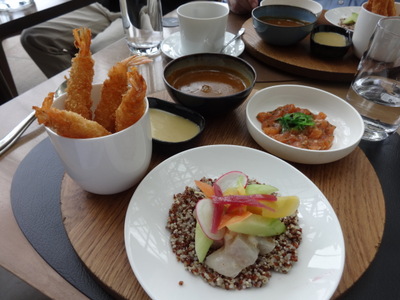
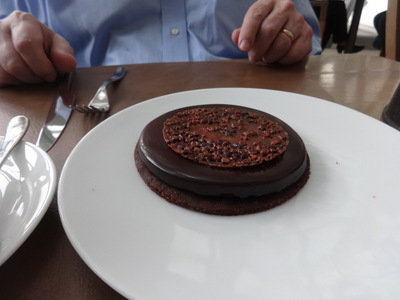 The restaurant had no composed salads as such, but they offered two of what they called "compositions," one vegetarian and one seafood. David and I both chose the latter, which consisted of a tartare of salmon with a little seaweed salad; cubes of marinated daurade (gilthead seabream) laid over a bed of quinoa and topped with wedges of fresh cucumber and thinly sliced radish, onion, and carrots (of two colors) marinated in a sweet pickling brine; a ferociously rich and flavorful soup of "étrilles" (eensy little crabs; they are cooked, then crushed, and the shells are strained out), and four hot crispy tempura shrimp (actually panko breaded, but whatever) with a lemongrass sauce for dipping. All delicious! These days, it's getting so I'm almost surprised to encounter cooked fish in a French restaurant.
The restaurant had no composed salads as such, but they offered two of what they called "compositions," one vegetarian and one seafood. David and I both chose the latter, which consisted of a tartare of salmon with a little seaweed salad; cubes of marinated daurade (gilthead seabream) laid over a bed of quinoa and topped with wedges of fresh cucumber and thinly sliced radish, onion, and carrots (of two colors) marinated in a sweet pickling brine; a ferociously rich and flavorful soup of "étrilles" (eensy little crabs; they are cooked, then crushed, and the shells are strained out), and four hot crispy tempura shrimp (actually panko breaded, but whatever) with a lemongrass sauce for dipping. All delicious! These days, it's getting so I'm almost surprised to encounter cooked fish in a French restaurant.
For dessert, we split this innocent looking disk of chocolate. They started with a flat round crisp cookie, then added a disk of rich dark chocolate ganache that had been glazed with an even darker melted chocolate, then topped the whole thing with a disk of crispy caramel with butter brickle bits in it. Excellent, but I certainly couldn't have eaten a whole one. I ate about 25% and David polished it off.
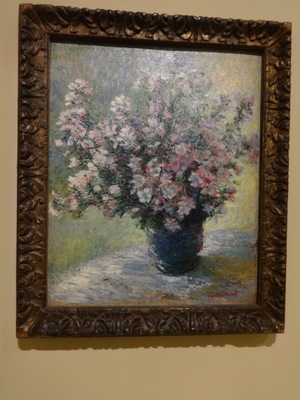
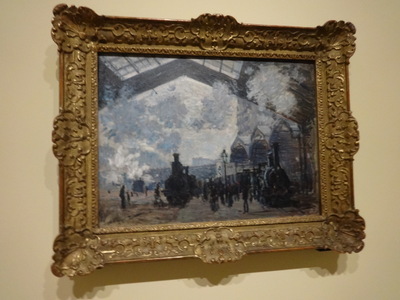 Samuel Courtauld (1876–1947) was a British industrialist principally known in that sphere for developing and marketing rayon, the first good, cheap silk substitute. But he was also an art collector (of French ancestry, hence the name) who left his collection to the institute named for him, usually housed in Somerset House in London. That space is currently undergoing renovation, so the whole collection as been temporarily shifted to the Vuitton, and it's a deusie!
Samuel Courtauld (1876–1947) was a British industrialist principally known in that sphere for developing and marketing rayon, the first good, cheap silk substitute. But he was also an art collector (of French ancestry, hence the name) who left his collection to the institute named for him, usually housed in Somerset House in London. That space is currently undergoing renovation, so the whole collection as been temporarily shifted to the Vuitton, and it's a deusie!
It starts with a lot of Art 100 pieces, like Manet's Un Bar au Folies-Bergère and van Gogh's Self Portrait with Bandaged Ear and goes from there. Here, I show a couple of Monets: at the left an uncharacteristic still life (he much preferred to paint his flowers "on the hoof") and his La Gare Saint-Lazare
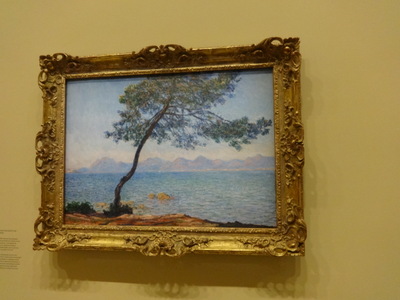
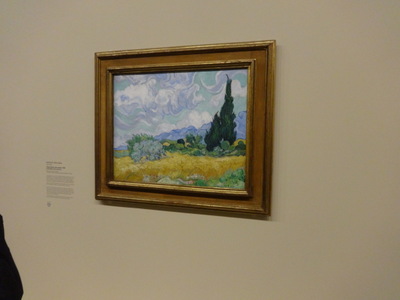 Here are Monet's Antibes (can you tell I like Monet?) and van Gogh's A Wheat Field with Cypresses.
Besides these artists, many others were included: Cézanne, Renoir, Degas, Gaugin, Modigliani, Toulouse-Lautrec, Seurat, Bonnard. Often, it included their lesser-known works (at least to me).
Here are Monet's Antibes (can you tell I like Monet?) and van Gogh's A Wheat Field with Cypresses.
Besides these artists, many others were included: Cézanne, Renoir, Degas, Gaugin, Modigliani, Toulouse-Lautrec, Seurat, Bonnard. Often, it included their lesser-known works (at least to me).
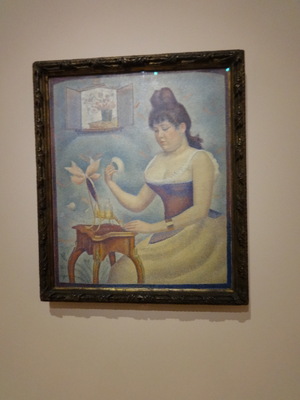
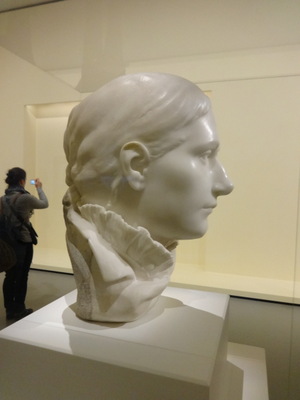 Here, for example, are a portrait by Seurat, Young Woman Powdering Herself, and a bust by Gaugin, of his wife Mette. Who knew he could even do that?!
Here, for example, are a portrait by Seurat, Young Woman Powdering Herself, and a bust by Gaugin, of his wife Mette. Who knew he could even do that?!
Mostly they let you get pretty close to the art, so I didn't have a lot of use for my binoculars, but they did come in handy for examining the Seurat works. You couldn't stand close enough to see the "points" he painted with, but by stepping back a couple of steps, I was able to focus in and see them with the binoculars.
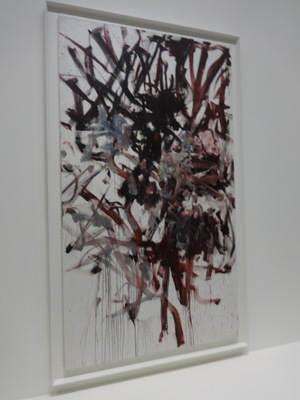
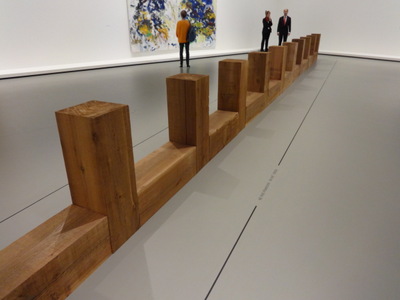 Once we'd seen the whole Courtauld collection, we went on to the Vuitton's permanent collection, but it didn't take us long. I have to say that the works were admirably displayed, with plenty of room and great lighting, but they were just not our favorite genre.
Once we'd seen the whole Courtauld collection, we went on to the Vuitton's permanent collection, but it didn't take us long. I have to say that the works were admirably displayed, with plenty of room and great lighting, but they were just not our favorite genre.
The Joan Mitchell work at the left, maybe five feet high, gives a good impression of what most of the others were like. It at least had a useful title, Red Tree; I can see that. But all those "untitled" pieces that suggest nothing in particular to me. Artist, if you don't know what you're trying to portray, even if its an abstraction or idea, how am I supposed to know?!
I actually liked the wooden thing shown at the right. I thought it was a really great design for museum benches until I got close enough to the markings on the floor to see that they said "Do not cross this line." So it must have been art, but I never found the label.
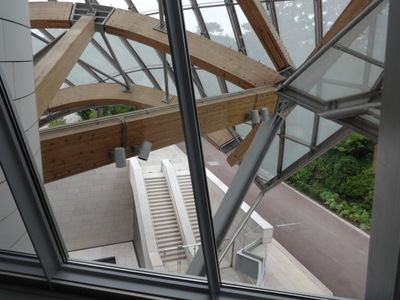
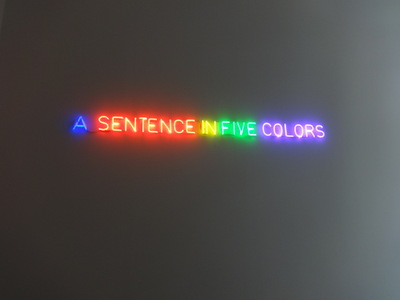 Other interesting things showed up as we wended our way. At the left here is a view out a window at the inside of some of the curved glass and metal panels that form the building's outer shell. You can't see it in this shot, but outside, beyond that end of the building was a stadium-jumping ring (although without viewing stands; probably just for practice). Near this window was a TV showing a 25-minute video work purporting to comment on Mondrian's use of primary colors. A man, visible from the neck down to table-top level continuously arranges red, yellow, and blue flowers in a vase, adding them, taking them out again, rearranging them. I didn't watch the whole thing, but according to the accompanying description, he arrives first at an all-red arrangement, then at and all-blue, and finally an all yellow, without ever being satisfied with any of them. And what got me was that none the arrangements was worth beans as an arrangement regardless of flower color!
Other interesting things showed up as we wended our way. At the left here is a view out a window at the inside of some of the curved glass and metal panels that form the building's outer shell. You can't see it in this shot, but outside, beyond that end of the building was a stadium-jumping ring (although without viewing stands; probably just for practice). Near this window was a TV showing a 25-minute video work purporting to comment on Mondrian's use of primary colors. A man, visible from the neck down to table-top level continuously arranges red, yellow, and blue flowers in a vase, adding them, taking them out again, rearranging them. I didn't watch the whole thing, but according to the accompanying description, he arrives first at an all-red arrangement, then at and all-blue, and finally an all yellow, without ever being satisfied with any of them. And what got me was that none the arrangements was worth beans as an arrangement regardless of flower color!
I did like the neon piece at the right, though. It says "A sentence in five colors," in five colors. Yes! work and title in one!
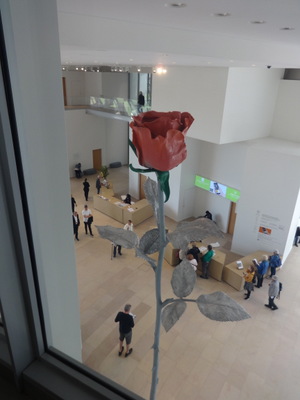
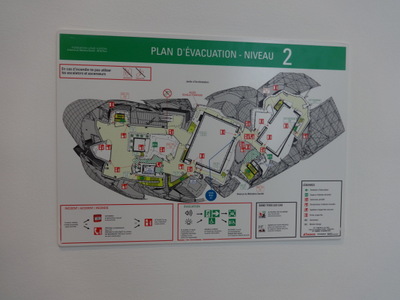 Through a window overlooking the main atrium/lobby, I finally got a shot of this 40-foot-tall rose, which I had seen from below but couldn't figure out how to photograph.
Through a window overlooking the main atrium/lobby, I finally got a shot of this 40-foot-tall rose, which I had seen from below but couldn't figure out how to photograph.
And just to give you an idea of what the place is like, physically, here at the right is a photo of the emergency-evacuation map of one of the levels (it has six, from -2 to 0 to 0+ to +2, all different in floor plan). Not a simple building.
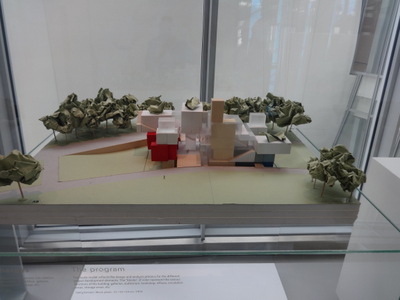
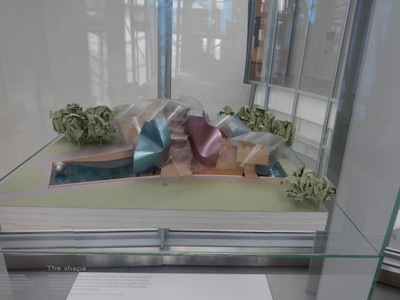 At the very end, we came to a collection of the architect's sketches and working models. At the left is his model of the building standing naked, as it were.
At the very end, we came to a collection of the architect's sketches and working models. At the left is his model of the building standing naked, as it were.
On the right is how he modeled it wearing its glass and metal wrapping panels, which, as I understand it, contribute nothing to the structural integrity of the building and must be a bear to clean.
By then, our feet had had it, so we went back out to the parvis (where people were still standing in line to get in) and caught the shuttle back to Étoile on the first try. Walked home and rested our feet until dinner.
Tarnsportation lines in the western 17th arrondissement of Paris, where we are staying, tend to run east-west, but our first three restaurants are NNE of us, so as far as public transit is concerned, you can't get there from here. So we walked to dinner, and will again tomorrow.
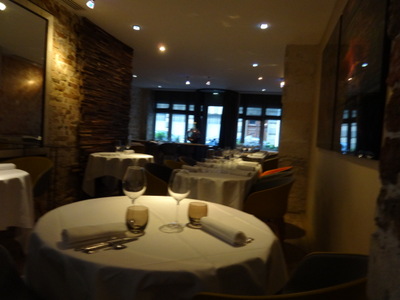
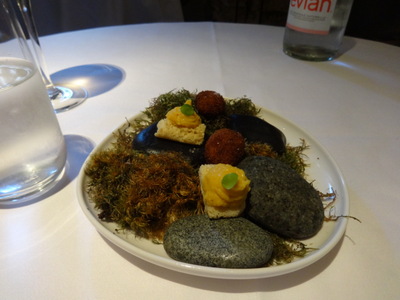 This evening's mean was at Restaurant Jacques Faussat, and it was great. We ordered the six-course surprise tasting menu. Here at the left is a view of the empty dining room just after we arrived. Immediately behind us is a tall counter, and behind that is the kitchen door.
This evening's mean was at Restaurant Jacques Faussat, and it was great. We ordered the six-course surprise tasting menu. Here at the left is a view of the empty dining room just after we arrived. Immediately behind us is a tall counter, and behind that is the kitchen door.
David ordered his usual glass of champagne, and with it came this little dish of moss and rocks with munchies lurking in it. One kind was little squares of savory sponge cake topped with piped cones of something orange (pumpkin or squash, maybe?). The other was hot spherical croquettes of garlic. The garlic had been simmered in milk or otherwise milded down, but it was still decidedly garlic.
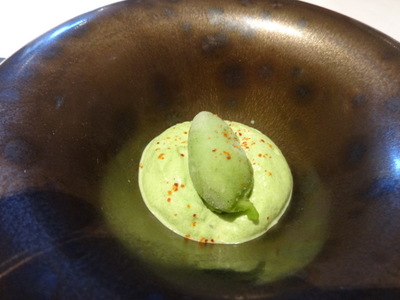
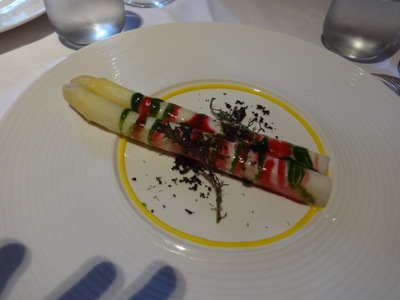 The official amuse-bouche was diced sweet cooked turnip cubes embedded in an arugula mousse, topped with a sweet parsley sorbet. The parsley sorbet was a little sweeter than, and even better than, the previous night's. Gotta try that at home. The little red sprinkles all over it are flakes of piment d'Espellette, that great red pepper from Basque country—Jacques is definitely, and proudly, from the southwest of France.
The official amuse-bouche was diced sweet cooked turnip cubes embedded in an arugula mousse, topped with a sweet parsley sorbet. The parsley sorbet was a little sweeter than, and even better than, the previous night's. Gotta try that at home. The little red sprinkles all over it are flakes of piment d'Espellette, that great red pepper from Basque country—Jacques is definitely, and proudly, from the southwest of France.
The first of the six courses was white asparagus striped, as you can see, with green (cilantro?) and red (beets) purées. The golden rim around the edge is a purée of "combava," an exotic citrus fruit. It was a good combination especially with the citrus, but the asparagus spears were a little tough and bitter at the cut ends—the only misstep of the meal.
David had ordered the wine pairings with the meal, so he got his first wine with the asparagus. He said the pairing was inspired (as all of them turned out to be), but we soon realized that, unlike most restaurants, this one won't serve your next course until you finish the glass of wine poured with the last. The same held true throughout the meal, so David wound up drinking a little more than he intended!
The chef himself did the pairings and came out to discuss each course and its wine with David.
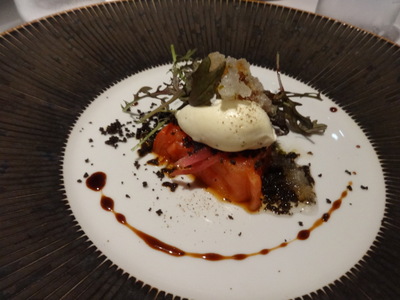
 The second course was heirloom tomato topped with a mascarpone mixture, baby arugula, and what looked like gray rock salt but turned out to be a citrus granité. The tomato was warm and lightly cooked. Yummy.
The second course was heirloom tomato topped with a mascarpone mixture, baby arugula, and what looked like gray rock salt but turned out to be a citrus granité. The tomato was warm and lightly cooked. Yummy.
About this time, in addition to a few other couples who showed up and were seated normally, a whole stream of informally dressed young women carrying a variety of briefcases, bags, and satchels, started coming in, singly or in groups, and were conducted right past us and out into the kitchen! Stragglers continued to arrive for another hour. We were intrigued. Was there another dining room back there? If he had a chef's table in the kitchen, it must be a really big one.
Our third course was monkfish with "scales" of strawberry and marinated radish slices, accompanied by peas and pea pur´e. If you eat in restaurants of pretention in Paris in June, you get a lot of peas and strawberries (and asparagus and pigeon and rhubarb and baby fava beans). It was sauced with a soy and vinegar reduction, so the chef rather daringly paired it with a slightly sweet wine, which David declared brilliant.
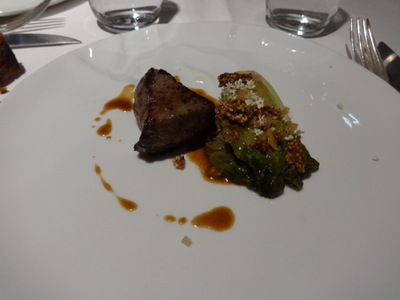
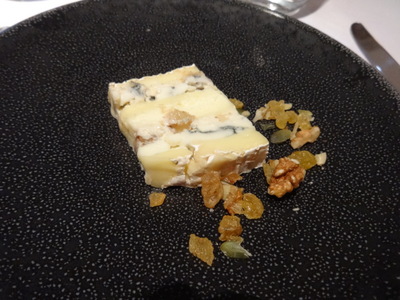 The fourth course—meat—was a piece of beef (he never said what cut) marinated in soy sauce, grilled rare. On the side, a whole head of "sucrine," a popular kind of miniature romaine, braied in meat juices and sprinkled with sesame brittle and elder flowers.
The fourth course—meat—was a piece of beef (he never said what cut) marinated in soy sauce, grilled rare. On the side, a whole head of "sucrine," a popular kind of miniature romaine, braied in meat juices and sprinkled with sesame brittle and elder flowers.
The fifth course was cheese: a sort of loaf that the chef concocted from layers of Brie, Roquefort, and a third cheese that sounded like "condoret" when he said it but was described on the on-line menu only as "Italian cheese." We each got a slice, garnished with chopped nuts and golden raisins. An excellent combination.
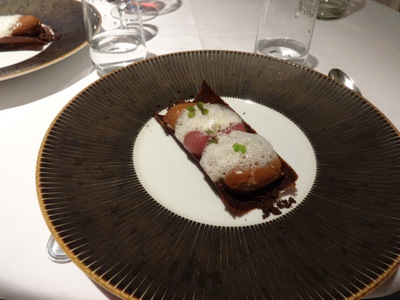
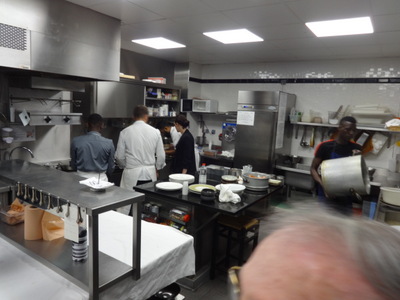 Last came dessert, a half-pipe-shaped chocolate tuile cookie containing two quenelles of chocolate ganache and one of red wine sorbet and topped with a foamy piment d'Espellette sauce. The wine sorbet was made with Maydie, a fortified red wine from the southwest of France, and the chef poured that with the dessert as well. The sorbet was good—not too alcoholic. David has had Maydie before with a chocolate dessert, but neither of us can remember where or when.
Last came dessert, a half-pipe-shaped chocolate tuile cookie containing two quenelles of chocolate ganache and one of red wine sorbet and topped with a foamy piment d'Espellette sauce. The wine sorbet was made with Maydie, a fortified red wine from the southwest of France, and the chef poured that with the dessert as well. The sorbet was good—not too alcoholic. David has had Maydie before with a chocolate dessert, but neither of us can remember where or when.
By this time, we were on pretty chummy terms with the chef. Like everyone else who has asked us on this trip, he's never heard of Tallahassee. Ah, the fleeting nature of fame. In 2000, everybody in the world had heard of Tallahassee, but now, less than 20 years later, that whole election debacle has been forgotten, and Tallahassee has once again sunk into obscurity without a trace.
The chef had visited Florida, though, to water ski and to visit a friend of his who has a restaurant in Sarasota called The Maison Blanche. I've looked it up— it's on Longboat Key north of the Mote Marine Lab.
When we got up from the table, and were putting on our coats, he asked if we'd like to see the kitchen. Of course! So he took us back to check it out—about four cooks and a dishwasher, in addition to the two servers we'd seen in the dining room. Out the back door of the kitchen was a wide alleyway in which chairs and tables could be set up if needed. On the one wall that got sun, he had a tall set of shelves bearing pots of the very herbs we'd been eating. No way he had enought of his own parsley to make that sorbet, so he must still buy some. Finally, farther back still, off the other side of the alleyway, we peeked through the window he indicated, and there they were! About 25 young women with satchels, sitting around a long table. They're cardiologists, he said, and meet regularly in his "salon" to compare notes!
Previous entry
List of Entries
Next entry

 On Thursday we had tickets for 1 p.m. to visit the Fondation Louis Vuitton in the Bois de Boulogne to see a special exhibition that included some impressionists. Accordingly, we set out on foot for Étoile to catch the Vuitton's electric shuttle bus, which starts running at 11 a.m. The plan was to get to the foundation in time to have lunch at their restaurant before visiting the collection. On the way, we passed this lovely old building with decorative corner towers. Colored tiles around the top of each cupola read "Magasins-Reunis Étoile" (United Stores, Étoile), but the building is now occupied by a FNAC (Fédération Nationale d’Achats des Cadres), which sells electronics, books, and recordings.
On Thursday we had tickets for 1 p.m. to visit the Fondation Louis Vuitton in the Bois de Boulogne to see a special exhibition that included some impressionists. Accordingly, we set out on foot for Étoile to catch the Vuitton's electric shuttle bus, which starts running at 11 a.m. The plan was to get to the foundation in time to have lunch at their restaurant before visiting the collection. On the way, we passed this lovely old building with decorative corner towers. Colored tiles around the top of each cupola read "Magasins-Reunis Étoile" (United Stores, Étoile), but the building is now occupied by a FNAC (Fédération Nationale d’Achats des Cadres), which sells electronics, books, and recordings.
 At the foundation, we found three looong queues waiting to get in: one for people buying tickets, one for people with tickets to get in on the hour, and (the longest) one for people with tickets to get in on the half hour.
At the foundation, we found three looong queues waiting to get in: one for people buying tickets, one for people with tickets to get in on the hour, and (the longest) one for people with tickets to get in on the half hour. 
 The restaurant is called "Le Frank" for Frank Gehry, who designed the building. He also designed the giant, glowing fish that hang from the restaurant's ceiling and serve as lighting fixtures. It's hard to see in my photo because they're silhouetted, but they're entirely white and constructed of translucent white scales as big as dinner plates.
The restaurant is called "Le Frank" for Frank Gehry, who designed the building. He also designed the giant, glowing fish that hang from the restaurant's ceiling and serve as lighting fixtures. It's hard to see in my photo because they're silhouetted, but they're entirely white and constructed of translucent white scales as big as dinner plates.
 The restaurant had no composed salads as such, but they offered two of what they called "compositions," one vegetarian and one seafood. David and I both chose the latter, which consisted of a tartare of salmon with a little seaweed salad; cubes of marinated daurade (gilthead seabream) laid over a bed of quinoa and topped with wedges of fresh cucumber and thinly sliced radish, onion, and carrots (of two colors) marinated in a sweet pickling brine; a ferociously rich and flavorful soup of "étrilles" (eensy little crabs; they are cooked, then crushed, and the shells are strained out), and four hot crispy tempura shrimp (actually panko breaded, but whatever) with a lemongrass sauce for dipping. All delicious! These days, it's getting so I'm almost surprised to encounter cooked fish in a French restaurant.
The restaurant had no composed salads as such, but they offered two of what they called "compositions," one vegetarian and one seafood. David and I both chose the latter, which consisted of a tartare of salmon with a little seaweed salad; cubes of marinated daurade (gilthead seabream) laid over a bed of quinoa and topped with wedges of fresh cucumber and thinly sliced radish, onion, and carrots (of two colors) marinated in a sweet pickling brine; a ferociously rich and flavorful soup of "étrilles" (eensy little crabs; they are cooked, then crushed, and the shells are strained out), and four hot crispy tempura shrimp (actually panko breaded, but whatever) with a lemongrass sauce for dipping. All delicious! These days, it's getting so I'm almost surprised to encounter cooked fish in a French restaurant.
 Samuel Courtauld (1876–1947) was a British industrialist principally known in that sphere for developing and marketing rayon, the first good, cheap silk substitute. But he was also an art collector (of French ancestry, hence the name) who left his collection to the institute named for him, usually housed in Somerset House in London. That space is currently undergoing renovation, so the whole collection as been temporarily shifted to the Vuitton, and it's a deusie!
Samuel Courtauld (1876–1947) was a British industrialist principally known in that sphere for developing and marketing rayon, the first good, cheap silk substitute. But he was also an art collector (of French ancestry, hence the name) who left his collection to the institute named for him, usually housed in Somerset House in London. That space is currently undergoing renovation, so the whole collection as been temporarily shifted to the Vuitton, and it's a deusie!

 Here are Monet's Antibes (can you tell I like Monet?) and van Gogh's A Wheat Field with Cypresses.
Besides these artists, many others were included: Cézanne, Renoir, Degas, Gaugin, Modigliani, Toulouse-Lautrec, Seurat, Bonnard. Often, it included their lesser-known works (at least to me).
Here are Monet's Antibes (can you tell I like Monet?) and van Gogh's A Wheat Field with Cypresses.
Besides these artists, many others were included: Cézanne, Renoir, Degas, Gaugin, Modigliani, Toulouse-Lautrec, Seurat, Bonnard. Often, it included their lesser-known works (at least to me).
 Here, for example, are a portrait by Seurat, Young Woman Powdering Herself, and a bust by Gaugin, of his wife Mette. Who knew he could even do that?!
Here, for example, are a portrait by Seurat, Young Woman Powdering Herself, and a bust by Gaugin, of his wife Mette. Who knew he could even do that?!
 Once we'd seen the whole Courtauld collection, we went on to the Vuitton's permanent collection, but it didn't take us long. I have to say that the works were admirably displayed, with plenty of room and great lighting, but they were just not our favorite genre.
Once we'd seen the whole Courtauld collection, we went on to the Vuitton's permanent collection, but it didn't take us long. I have to say that the works were admirably displayed, with plenty of room and great lighting, but they were just not our favorite genre.
 Other interesting things showed up as we wended our way. At the left here is a view out a window at the inside of some of the curved glass and metal panels that form the building's outer shell. You can't see it in this shot, but outside, beyond that end of the building was a stadium-jumping ring (although without viewing stands; probably just for practice). Near this window was a TV showing a 25-minute video work purporting to comment on Mondrian's use of primary colors. A man, visible from the neck down to table-top level continuously arranges red, yellow, and blue flowers in a vase, adding them, taking them out again, rearranging them. I didn't watch the whole thing, but according to the accompanying description, he arrives first at an all-red arrangement, then at and all-blue, and finally an all yellow, without ever being satisfied with any of them. And what got me was that none the arrangements was worth beans as an arrangement regardless of flower color!
Other interesting things showed up as we wended our way. At the left here is a view out a window at the inside of some of the curved glass and metal panels that form the building's outer shell. You can't see it in this shot, but outside, beyond that end of the building was a stadium-jumping ring (although without viewing stands; probably just for practice). Near this window was a TV showing a 25-minute video work purporting to comment on Mondrian's use of primary colors. A man, visible from the neck down to table-top level continuously arranges red, yellow, and blue flowers in a vase, adding them, taking them out again, rearranging them. I didn't watch the whole thing, but according to the accompanying description, he arrives first at an all-red arrangement, then at and all-blue, and finally an all yellow, without ever being satisfied with any of them. And what got me was that none the arrangements was worth beans as an arrangement regardless of flower color!
 Through a window overlooking the main atrium/lobby, I finally got a shot of this 40-foot-tall rose, which I had seen from below but couldn't figure out how to photograph.
Through a window overlooking the main atrium/lobby, I finally got a shot of this 40-foot-tall rose, which I had seen from below but couldn't figure out how to photograph.

 At the very end, we came to a collection of the architect's sketches and working models. At the left is his model of the building standing naked, as it were.
At the very end, we came to a collection of the architect's sketches and working models. At the left is his model of the building standing naked, as it were. 
 This evening's mean was at Restaurant Jacques Faussat, and it was great. We ordered the six-course surprise tasting menu. Here at the left is a view of the empty dining room just after we arrived. Immediately behind us is a tall counter, and behind that is the kitchen door.
This evening's mean was at Restaurant Jacques Faussat, and it was great. We ordered the six-course surprise tasting menu. Here at the left is a view of the empty dining room just after we arrived. Immediately behind us is a tall counter, and behind that is the kitchen door.
 The official amuse-bouche was diced sweet cooked turnip cubes embedded in an arugula mousse, topped with a sweet parsley sorbet. The parsley sorbet was a little sweeter than, and even better than, the previous night's. Gotta try that at home. The little red sprinkles all over it are flakes of piment d'Espellette, that great red pepper from Basque country—Jacques is definitely, and proudly, from the southwest of France.
The official amuse-bouche was diced sweet cooked turnip cubes embedded in an arugula mousse, topped with a sweet parsley sorbet. The parsley sorbet was a little sweeter than, and even better than, the previous night's. Gotta try that at home. The little red sprinkles all over it are flakes of piment d'Espellette, that great red pepper from Basque country—Jacques is definitely, and proudly, from the southwest of France.
 The second course was heirloom tomato topped with a mascarpone mixture, baby arugula, and what looked like gray rock salt but turned out to be a citrus granité. The tomato was warm and lightly cooked. Yummy.
The second course was heirloom tomato topped with a mascarpone mixture, baby arugula, and what looked like gray rock salt but turned out to be a citrus granité. The tomato was warm and lightly cooked. Yummy.
 The fourth course—meat—was a piece of beef (he never said what cut) marinated in soy sauce, grilled rare. On the side, a whole head of "sucrine," a popular kind of miniature romaine, braied in meat juices and sprinkled with sesame brittle and elder flowers.
The fourth course—meat—was a piece of beef (he never said what cut) marinated in soy sauce, grilled rare. On the side, a whole head of "sucrine," a popular kind of miniature romaine, braied in meat juices and sprinkled with sesame brittle and elder flowers.
 Last came dessert, a half-pipe-shaped chocolate tuile cookie containing two quenelles of chocolate ganache and one of red wine sorbet and topped with a foamy piment d'Espellette sauce. The wine sorbet was made with Maydie, a fortified red wine from the southwest of France, and the chef poured that with the dessert as well. The sorbet was good—not too alcoholic. David has had Maydie before with a chocolate dessert, but neither of us can remember where or when.
Last came dessert, a half-pipe-shaped chocolate tuile cookie containing two quenelles of chocolate ganache and one of red wine sorbet and topped with a foamy piment d'Espellette sauce. The wine sorbet was made with Maydie, a fortified red wine from the southwest of France, and the chef poured that with the dessert as well. The sorbet was good—not too alcoholic. David has had Maydie before with a chocolate dessert, but neither of us can remember where or when.